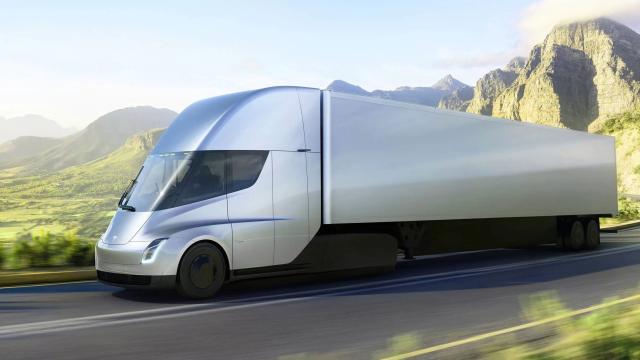Tesla has been promising an expanded product line beyond the S, 3, X, and Y for a handful of years now, but thus far none of those projects have amounted to anything concrete. While the company’s sedans and hunch-backed crossovers continue to sell in ever increasing numbers, the battery electric roadster, pickup truck, and tractor trailer remain fugazi. When each of these three models were shown off, they were ascribed headline-grabbing stats which were impossible with then-current technology, and timelines which have come and gone without delivery.
Let’s start with the Roadster, which was first shown in late 2017. It promised 998 km of range, 8-second quarter km times, and a $US200,000 ($261,720) price tag. Customers were asked for a $US50,000 ($65,430) deposit, while buyers of the Founders Edition put down a full-boat $US250,000 ($327,150) over three years ago for a car which has still not shown up.
Finishing engineering this year, production starts next year. Aiming to have release candidate design drivable late summer. Tri-motor drive system & advanced battery work were important precursors.
— Elon Musk (@elonmusk) January 28, 2021
While delivering a car five years after an initial launch isn’t unprecedented. I mean, that’s Acura NSX and Toyota Supra levels of lead-in. But aside from a tweet from the head honcho himself, we have no actual indication from the company when, you know, we might actually see the thing.
“We are making it now,” said Musk at the November 2017 launch of the Roadster. Apparently people can just say things.
OK, so what about the Semi? The massive battery-powered truck with a claimed 0-100 time in the 5-second range and 805 km of range has been floating around since that same launch event night in November 2017. This one, at a minimum, has been spotted testing along I-80 in California and northern Nevada. I’ve seen it with my own two eyes. So what’s the holdup?
Musk said on the Q4 earnings call that the first Semi would be delivered “by the end of 2021” once the company began production of its own 4680 battery cells. “Prototypes are easy, scaling production is very hard,” said Musk of the semi. This does not even seem to take into account that Tesla does not currently have a factory in which to produce the Semi. The company’s California facility is packed to the gills and Texas Giga has not been completed yet.
The fact of the matter is that Tesla had previously put a priority on the Semi. On the night of its reveal, Musk claimed deliveries to customers would begin in 2019. This makes sense, as big industrial contracts are quite lucrative, and Tesla has already sold hundreds of these trucks to everyone from Walmart to UPS. You don’t want to piss off a massive wealthy family like the Waltons by shipping them trucks three years late. By early 2020, the delivery date was kicked out to 2021.
“The main reason we’ve not accelerated new products is — like for example Tesla Semi — is that we simply don’t have enough cells for it. If we were to make the Semi like right now, which we could easily go into production with the Semi, but we would not have enough cells for it right now. We will have enough cells for Semi when we are producing the Tesla 4680 in volume.”
“Basically we do not see any issues with creating a compelling long-range truck with batteries apart from cell supply,” Musk said.
OK, so that leaves us with the much anticipated and scarcely believed Cybertruck. Where the heck is it? When the Cybertruck was unveiled in 2019, once again Musk gave a promise of a 2021 production date. It’s still quite early in 2021, and I suppose it’s possible that the company can finish building the factory and then gear up to produce an electric pickup, but even Elon doesn’t believe it to be likely. He’s already begun hedging his bets on delivering CT on time.
“If we get lucky, we’ll be able to do a few deliveries toward the end of this year, but I expect volume productions to begin in 2022,” Musk said. “We finished almost all of the Cybertruck engineering. So we’re no longer iterating at the design centre level or design level. We’ve got the designs fixed. We will soon order the equipment necessary to make the Cybertruck work. We’re actually going to be using even bigger Tesla machines for the rear body of Cybertruck because we’ve got, obviously, it’s a bigger vehicle and you’ve got a long truck bed. So we’ll be using an 7,257 T casting press for the rear body casting as opposed to 6,000-ton for Model Y.”
Tesla have not yet begun ordering the equipment necessary to build the Cybertruck, which does not bode well for the truck delivering on the original timeline. I wouldn’t be surprised to see that production date stretch out another year, with first examples delivering in 2022 and serious production capacity ramped up into 2023 at the earliest.
Saying “If we get lucky,” says a lot without saying very much. Pretty much every time Elon has told the world when Tesla would deliver something, the company has fallen short of its goals. What happened to under-promising and overdelivering?
